the 2007 Abstract Presentations - Wound Healing Society
the 2007 Abstract Presentations - Wound Healing Society
the 2007 Abstract Presentations - Wound Healing Society
You also want an ePaper? Increase the reach of your titles
YUMPU automatically turns print PDFs into web optimized ePapers that Google loves.
<strong>Abstract</strong>s<br />
114<br />
ROLE OF NEUROINFLAMMATORY MARKERS IN<br />
ISCHEMIC DIABETIC WOUND HEALING<br />
Leena Pradhan, Xuemei Cai, Nicholas Andersen, Monica Jain, Junaid Malek,<br />
Mauricio Contreras, Frank W. LoGerfo, and Aristidis Veves<br />
Dept. of Surgery, Beth Israel Deaconess Medical Center, Harvard Medical<br />
School, Boston, MA<br />
Introduction: Abnormal wound healing is <strong>the</strong> key cause of Diabetic Foot<br />
Ulceration (DFU). Dysregulation in <strong>the</strong> expression and activity of inflammatory<br />
cytokines involved in <strong>the</strong> healing process, followed by reduced infiltration<br />
and angiogenesis, can disrupt normal wound healing, contributing both to <strong>the</strong><br />
development of DFU and its failure to heal. Neuropeptides such as Substance P<br />
(SP) and Neuropeptide Y (NPY) secreted from peripheral nerves are also<br />
implicated in abnormal wound healing. The present study is designed to<br />
investigate <strong>the</strong> role of cytokines and neuropeptides in wound healing.<br />
Model: Diabetic and non-diabetic rabbit ears are made ischemic by interrupting<br />
dermal circulation to <strong>the</strong> left ear by ligating <strong>the</strong> rostral and central arteries.<br />
The right ear serves as a sham. Four full thickness circular wounds are created<br />
in both ears using a 6-mm punch biopsy. Ten days post-surgery, rabbits are<br />
euthanized and wounds are harvested.<br />
Analysis: <strong>Wound</strong> healing is monitored using Medical Hyperspectral Imaging<br />
(MHSI) collected with a HyperMed Visible MHSI System (Watertown, MA).<br />
<strong>Wound</strong>s are monitored for infiltration using histology and Q-RT-PCR and<br />
Immunohistochemistry is used to asses <strong>the</strong> gene and protein expression of<br />
cytokines IL-6 and IL-8, <strong>the</strong>ir receptors gp130 and CXCR1 respectively, and SP<br />
and NPY.<br />
Results: Compared to <strong>the</strong> non-diabetic controls, <strong>the</strong> ischemic wounds heal<br />
slower, have reduced infiltration and increased pre-wounding skin gene expression<br />
of IL-6, IL-8, gp130 and CXCR1 in <strong>the</strong> diabetic rabbits. Post-wounding,<br />
<strong>the</strong> increase in gene expression of IL-6, IL-8, gp130, and CXCR1 over <strong>the</strong> prewounding<br />
baseline is reduced in diabetic rabbits compared to <strong>the</strong> non-diabetic<br />
controls. <strong>Wound</strong>ing decreased <strong>the</strong> expression of SP and NPY in both diabetic<br />
and non-diabetic rabbits.<br />
Conclusion: Preliminary results suggest that <strong>the</strong>re is a dysregulation of immune<br />
response to wounding in <strong>the</strong> diabetic ischemic wounds and neuropeptides are<br />
altered in wound healing.<br />
115<br />
DOES HBO2T CAUSE HYPOGLYCEMIA IN DIABETIC<br />
PATIENTS? A REVIEW OF 119 DIABETIC PATIENTS<br />
TREATED IN A MULTIPLACE CHAMBER<br />
Irfan Qureshi MD, Ka<strong>the</strong>rine Gasho SSF, Liqi FanBS, and George A.<br />
Perdrizet MD, PhD<br />
FACS Hartford Hospital Center for <strong>Wound</strong> <strong>Healing</strong> and Hyperbaric Medicine<br />
Introduction: There is a perception that diabetic patients are at risk for<br />
hypoglycemic reactions while receiving HBO2 T. We <strong>the</strong>refore established a<br />
policy of aggressive blood glucose monitoring of all diabetic patients referred to<br />
our wound center for hyperbaric oxygen treatments to determine <strong>the</strong> incidence<br />
and severity of this HBO2T related hypoglycemia.<br />
Methods: Blood glucose (BG) was tested for all diabetic patients before, after<br />
and while receiving HBO2T, by standard point of care testing methods. IRB<br />
approval was obtained. Comparisons were made using <strong>the</strong> Student’s t-test.<br />
Hypoglycemia is defined as a blood sugar 60 mg/dL.<br />
Results: One-hundred and nineteen diabetic patients had BG sampled 3, 450<br />
times over a 3-year time period (8/2003–8/2006). The mean blood sugar values<br />
decreased from <strong>the</strong> pre-HBO2T (174 43 mg%), to <strong>the</strong> during HBO2T<br />
(137 36 mg%) and <strong>the</strong> post-HBO2 T (157 42 mg% measurements. The<br />
differences between <strong>the</strong> pre HBO2 T measurement and subsequent two time<br />
points were statistically significant with p o 0.04. The overall incidence of a<br />
hypoglycemic episode was found to be 68 out of 2,068 (3.3%) blood sugar<br />
values which occurred in 24 out of 119 (20%) patients. All hypoglycemic<br />
episodes were asymptomatic.<br />
Conclusion: Mean BG values are significantly elevated above normal in<br />
patients presenting to our center for daily HBO2T. Mean BG values do<br />
decrease during treatment, however <strong>the</strong> majority of patients remain in <strong>the</strong><br />
hyperglycemic range. The incidence of hypoglycemia is low and likely reflects<br />
our policy of aggressive blood sugar monitoring and liberal administration of<br />
glucose BG less than 70 mg/dL.<br />
116<br />
HEME OXYGENASE EXPRESSION IN HUMAN WOUNDS<br />
L.A. Gilman 1 , R.A. Kulina 1 , T. Dechert 2 , C.R. Pruitt 1 , R.G. Lewis 2 , and<br />
D.R. Yager 1,2<br />
1 Department of Physiology and <strong>the</strong><br />
2 Division of Plastic & Reconstructive Surgery of <strong>the</strong> Department of Surgery,<br />
Virginia Commonwealth University, Richmond, Virginia<br />
Heme oxygenase is a major acute-phase protein that catalyzes <strong>the</strong> conversion of<br />
free heme into biliverdin/bilirubin, carbon monoxide, and iron. Heme oxygenase<br />
has been shown to provide important cytoprotective functions in tissues<br />
subject to oxidative stress. Free heme possesses pro-oxidant and pro-inflammatory<br />
properties whereas biliverdin/bilirubin is an extremely potent anti-oxidant<br />
system. In addition, carbon monoxide is a vasodilator, an inhibitor of<br />
inflammatory adhesion molecule expression, and an inhibitor of inflammatory<br />
cell recruitment. Because of its potential importance in modulating oxidative<br />
stress and inflammation, we examined <strong>the</strong> expression of heme oxygenase<br />
protein in human acute healing wounds and in pressure ulcers. Histochemistry<br />
revealed <strong>the</strong> presence of <strong>the</strong> inducible isoform of heme oxygenase (HO-1) in <strong>the</strong><br />
granulation tissue of human open (4 mm) dermal wounds. HO-1 protein colocalized<br />
with cells expressing CD68 suggesting expression by macrophages.<br />
Immunoblot analysis (n = 5) indicated that peak expression of HO-1 occurred<br />
7–14 days post-wounding. This correlated with markers of neutrophil infiltration<br />
and oxidative stress. Immunoblot analysis revealed constitutive expression<br />
of HO-2 that did not correlate with specific cells, tissues, or time. HO-1 protein<br />
staining also co-localized with CD68 positive cells in pressure ulcers. Immunoblot<br />
analysis indicated that <strong>the</strong> mean level of HO-1 protein in pressure ulcers<br />
(n = 10) was significantly higher than at any time point of healing wounds. This<br />
is <strong>the</strong> first report examining heme oxygenase expression in normal and<br />
pathologic human wounds. The potential of this enzyme and its products to<br />
reduce oxidative stress and inflammation makes it an appealing target.<br />
Acknowledgments: This research was funded by <strong>the</strong> A.D. Williams Fund.<br />
117<br />
MALIGNANCY IN CHRONIC WOUNDS<br />
F.J. Agullo, A.A. Santillan, H. Palladino, W.T. Miller<br />
Texas Tech University Health Sciences Center School of Medicine, Department<br />
of Surgery, El Paso, TX USA<br />
The prevalence of malignancy within chronic skin ulcers is low, resulting in<br />
frequent inappropriate diagnosis and treatment. These malignancies may arise<br />
from chronic wounds or <strong>the</strong> ulceration itself may be caused by <strong>the</strong> cancer.<br />
Commonly, <strong>the</strong>se lesions are treated as chronic wounds, leading to delayed<br />
diagnosis and resulting in <strong>the</strong> need for more extensive surgery and increased<br />
risk of metastasis and mortality. Three cases are presented depicting varied<br />
pathophysiology, diagnosis, and treatment of malignancies encountered within<br />
chronic ulcers. All cases resulted in delayed treatment, ranging between 18<br />
months to a year, due to inadequate diagnosis and treatment as chronic<br />
wounds. On referral, due to clinical suspicion, biopsies demonstrated malignancies<br />
including melanoma, basosquamous carcinoma, and squamous cell<br />
carcinoma. Excision and wound coverage was <strong>the</strong> mainstay of <strong>the</strong>rapy.<br />
Suspicion of malignant change should be raised with wounds that are<br />
malodorous, crusted, ulcerated, bleeding, or have had an increase in pain or<br />
size. <strong>Wound</strong>s that have an irregular base or margins, a change in drainage, or<br />
exophytic growth should also be suspect and merit a biopsy. Some clinicians<br />
advocate performing biopsies on wounds that have been present for longer than<br />
3 or 4 months. Marjolin ulcers, giant basosquamous carcinomas, and melanomas<br />
are malignant entities with high metastatic potential that can present as<br />
chronic skin ulcerations. The cases described represent extremes in <strong>the</strong> presentation<br />
of malignant transformation in chronic wounds and serve as<br />
important reminders of <strong>the</strong> need for clinicians to aggressively evaluate and<br />
manage chronic wounds of any etiology that follow a stagnant progressive<br />
course. These reports highlight <strong>the</strong> possibility of malignancy in chronic wounds<br />
and ulcers, and <strong>the</strong> importance of early identification and treatment.<br />
Acknowledgments: No financial interests.<br />
<strong>Wound</strong> Rep Reg (<strong>2007</strong>) 15 A14–A54 c <strong>2007</strong> by <strong>the</strong> <strong>Wound</strong> <strong>Healing</strong> <strong>Society</strong><br />
A45




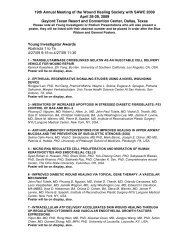

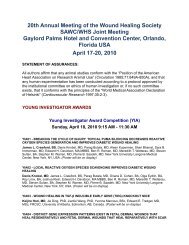
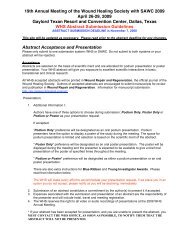
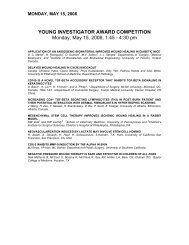



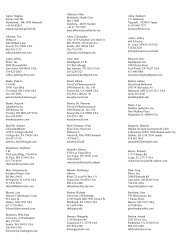
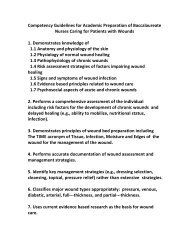
![2010 Abstracts-pah[2] - Wound Healing Society](https://img.yumpu.com/3748463/1/190x245/2010-abstracts-pah2-wound-healing-society.jpg?quality=85)